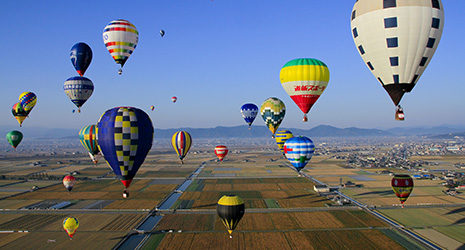Home > Highlighting JAPAN > Highlighting Japan October 2016 > Kyushu Calling
Highlighting JAPAN


Up, Up and Away
The rise of the Saga International Balloon Fiesta
Saga plain in the northwest of Kyushu is land on which rice has been cultivated since ancient times. The plain is some 700 km2 in size and, with the exception of one or two built-up areas, it is covered with rice fields as far as the eye can see, even today.
Every October for the last thirty-six years, Saga plain has served as the venue for the Saga International Balloon Fiesta. The first Balloon Fiesta in 1980 featured fourteen hot air balloons. Since then, the scale of the festival has grown larger every year. Approximately 100 hot air balloons from countries around the world have participated in the event in each of the last several years, and the festival now attracts approximately 800,000 spectators from all over Japan, making it the biggest balloon festival anywhere in Asia.
“There are no obstacles such as tall buildings in the rice fields, and in autumn or winter after the rice is harvested, the balloons are able to take off and land in the fields thanks to the cooperation of the farmers,” says Seishiro Yuzuriha of the Economics Department of Saga City. “Moreover, while the Ariake Sea, the largest bay in Kyushu, lies to the south of the Saga plain, mountains 1,000 meters above sea level, such as Tenzan and Sefurisan mountains, stand to the north. The wind blowing in from the sea and the wind issuing down from the mountains collide in the air above the Saga plain, causing complex wind flows. This creates the ideal conditions for a hot air balloon competition.”
Unlike airships, hot air balloons do not have propellers. However, they can be made to ascend or descend by heating or cooling the air inside the envelope using a burner that is installed in a basket. As the direction and strength of the winds are different at different altitudes, balloonists control their direction by adjusting the altitude of their balloon. In a competition, the aim is mainly for the balloons to reach designated goal carrying out a variety of tasks, such as dropping markers (lightweight bag with a tail) onto a target on the ground. For this reason, it is more important than anything else to accurately read the complex wind flows.
“In Saga City, there are approximately forty hot air balloon clubs at present, including those at high schools and universities that are unique to Japan,” says Yuzuriha. “Many people enjoy hot air ballooning. And because local residents have the opportunity to enjoy hot air balloons in flight, many choose to participate in the preparation and management of the festival on a voluntary basis.”
During the Balloon Fiesta, many competitors and related parties come to the area from overseas, and many of them home-stay in the houses of ordinary citizens. At the festival gathering place meanwhile, handmade dishes using local foods are provided. This type of hospitality is greatly appreciated by the visiting participants.
This year’s festival will be held over ten days between October 28 and November 6, and as this year’s event is the FAI World Hot Air Balloon Championship, it will officially be called the 22nd FAI World Hot Air Balloon Championship SAGA 2016. The 2016 Hot Air Balloon Honda Grand Prix will also be held during the festival, along with the Balloon Fantasia featuring character-shaped balloons, and an event called La Montgolfier Nocturne, in which colorful hot air balloons illuminated by the fires of their burners will emerge from the dark accompanied by fireworks and music. The total number of participating balloons is expected to exceed the previous record of 187, and the number of spectators is likely to be a record 1.2 million.
“When the rice harvest is over, everybody in Saga starts to say that the balloon season has arrived,” says Yuzuriha. “We would like to continue to enhance the Balloon Fiesta of Saga as an event that is admired and loved by the local communities, and that people will be proud of in the future.”
© 2009 Cabinet Office, Government of Japan







